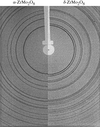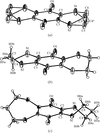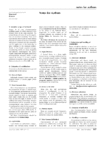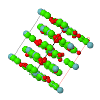issue contents
February 2001 issue

Cover illustration: The structure of Pu31Pt20 [D. T. Cromer & A. C. Larson (1977). Acta Cryst. B33, 2620-2627] viewed nearly perpendicular to a Pu, Pt disc (10 Å thick and 50 Å in diameter) down [111]. Details of the structure were taken from the intermetallics crystal structure database CRYSTMET® using the Materials ToolKit graphics software from Toth Information Systems, Inc.
topical reviews
The fascinating three-dimensional architectures of metal phosphates and related materials are shown to be formed by a progressive building-up process, starting from low-dimensional structures. Accordingly, the zero- and one-dimensional structures act as synthons in the formation of these structures.
research papers
The crystal structure of Nd10W22O81 has been determined, using a combination of high-resolution transmission electron microscopy and X-ray powder diffraction methods. Nd10W22O81 is a new type of pentagonal column (PC) structure.
Download citation


Download citation


The structure of the monoclinic high-pressure phase δ-ZrMo2O8 has been solved by direct methods and refined using high-pressure synchrotron X-ray powder diffraction data. Rietveld refinements of the α- and δ-phase from 0.2 to 1.9 GPa have been performed.
Download citation


Download citation


The kinetic behaviour of nitric acid dihydrate, HNO3·2H2O, proves its possible crystallization. From a single crystal the molecular and crystal structures have been determined, revealing a two-dimensional hydrogen-bond network, and molecular arrangement intermediate between those of the monohydrate and the trihydrate of nitric acid.
Download citation


Download citation


The crystal structure of manganese diacetate tetrahydrate has been determined by single-crystal neutron diffraction. A quantum model is proposed to account for the observed proton density distributions and the rotational dynamics of methyl groups observed by inelastic neutron scattering.
Download citation


Download citation


The crystal structures and absolute configurations of three cis-β1 and three cis-β2 isomers of [Co(trien)(L-aminoacidato)]2+ are reported, as are their crystallization behavior and packing features.
Download citation


Download citation


The title compounds represent a new group of fungicides characterized by substantial photodynamic activity. Their conformation is controlled by stereoelectronic interactions which help to reduce the large electron-withdrawing capacity of the sulfonyl group. Additionally, strong intramolecular resonance-assisted hydrogen bonds between the sulfonyl and α-phenylhydrazono groups exist in two of the compounds investigated. The strength of these bonds and the stereoelectronic back-donation are mutually related.
Download citation


Download citation


The structures of five members of a new class of compounds have been determined by X-ray diffraction. Comparison of the measured bond lengths with their quantum chemically calculated counterparts might lead to erroneous conclusions if correlation energy is omitted from the calculations.
Download citation


Download citation


To elucidate the structural features caused by C-amidation of amino acids, the crystal structures of HCl salts of C-amidated Ile, Val, Thr, Ser, Met, Trp, Gln and Arg have been analysed and compared with those of the corresponding amino acids. The Cα—H⋯O hydrogen bonds, intermolecular carbonyl–carbonyl interactions and the interaction patterns with Cl ions could be considered as structural features which differentiate both molecules from each other.
Download citation


Download citation


The crystal structures of two tetrathiabenzoquinone derivatives were found to form characteristic one-dimensional molecular columns and two-dimensional or quasi two-dimensional molecular sheets.
A program to detect molecular symmetry in selected crystal structures from the Cambridge Structural Database is reported, plus an implementation of the display of symmetry elements.
Download citation


Download citation


Organic salts formed between ethane-1,2-diphosphonic acid and the diamines piperazine and 4,4′-trimethylenedipiperidine are both characterized by richly complex intermolecular hydrogen bonding, giving two different three-dimensional framework structures.
short communications
Database study on the competitive effects involving the carboxyl group. A correlation between the success in competition and the average hydrogen-bond distance is established.
international union of crystallography
Free 

book reviews
Free 



 journal menu
journal menu
































